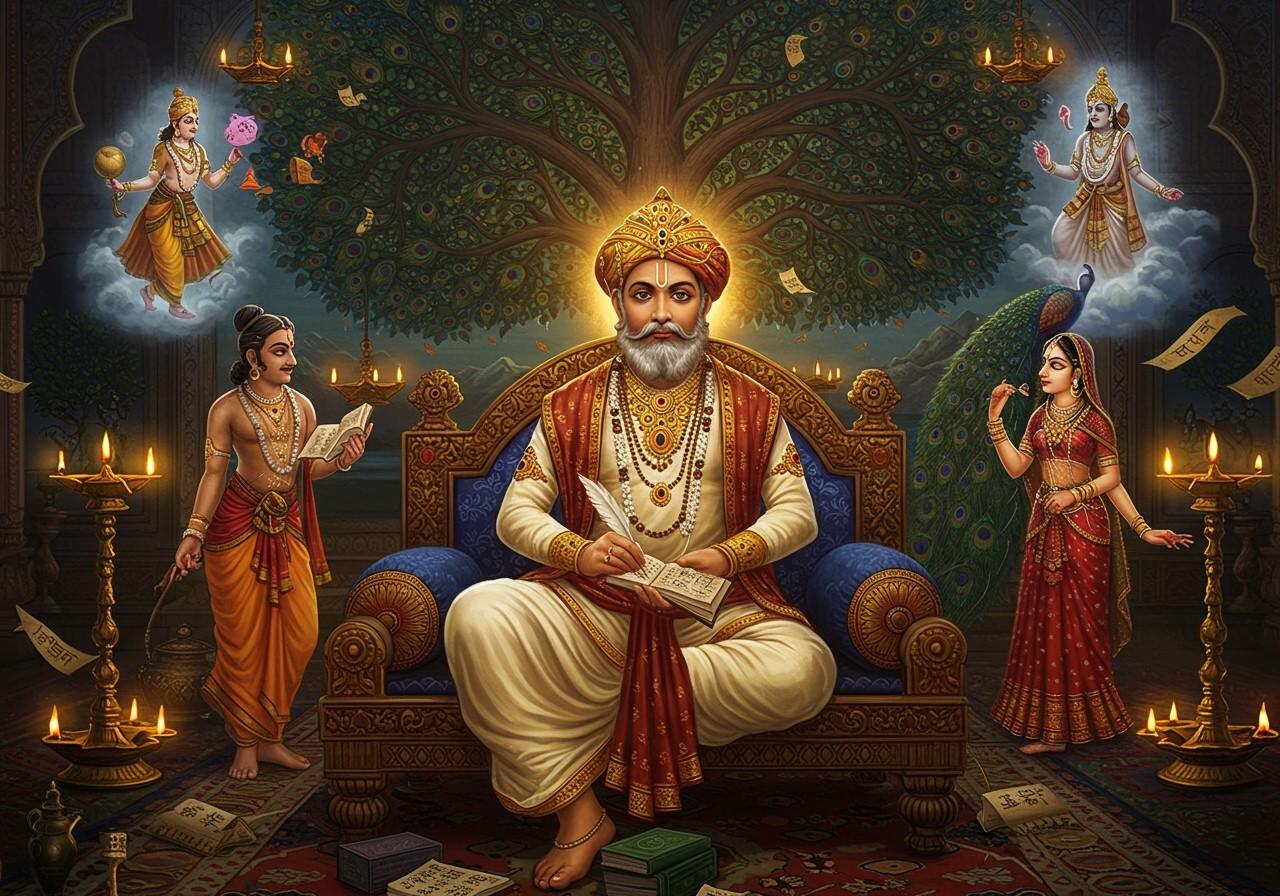
Kalidasa, often hailed as “India’s Shakespeare,” stands as a monumental figure in classical Sanskrit literature. His timeless works, dating back to the 4th-5th century CE, continue to mesmerize with their poetic brilliance and profound philosophical depth. This exploration delves into the reasons behind this esteemed title, examines his contemporaries, and investigates the origins of this compelling comparison.
The Parallels Between Kalidasa and Shakespeare
The comparison between Kalidasa and Shakespeare arises from several key similarities:
- Mastery of Language: Kalidasa’s command over Sanskrit is unparalleled, mirroring Shakespeare’s mastery of the English language. His intricate wordplay and evocative descriptions create a rich tapestry of imagery and emotion, establishing him as a true wordsmith of his time. His profound understanding of Sanskrit grammar and vocabulary allowed him to craft verses of exceptional beauty and depth.
- Universal Themes: Much like Shakespeare, Kalidasa explored timeless themes that resonate across cultures and eras. Love, loss, duty, and the complexities of human relationships form the core of his narratives, offering profound insights into the human condition. These universal themes ensure his works remain relevant and engaging even today.
- Influence on Culture: Kalidasa’s impact on Indian literature, theater, and arts is undeniable, comparable to Shakespeare’s influence on English literature. His works have shaped artistic expression for centuries, inspiring countless writers, poets, and playwrights. His influence can be seen in various art forms, from classical dance to modern cinema.
- Diverse Body of Work: Kalidasa’s literary repertoire includes plays, epic poems (like Raghuvamsha and Kumarasambhava), and shorter poems, showcasing his versatility as a writer, similar to Shakespeare’s diverse portfolio of tragedies, comedies, and sonnets. This range demonstrates his mastery of different literary forms and his ability to captivate audiences with varied narratives.
- Complex Characters: Both authors demonstrated a remarkable ability to craft complex and relatable characters. Their protagonists grapple with moral dilemmas, experience profound emotions, and undergo transformative journeys, drawing readers into their inner worlds. These characters are not mere archetypes but individuals with their own strengths, weaknesses, and motivations.
- Literary Techniques: Kalidasa masterfully employed symbolism, metaphors, and other literary devices to enrich his narratives, much like Shakespeare. These techniques add layers of meaning to his works, inviting readers to delve deeper into the text and uncover hidden truths. His use of imagery, particularly from nature, is both evocative and symbolic.
- Enduring Legacy: Both Kalidasa and Shakespeare have left behind a rich literary legacy that continues to be celebrated and studied worldwide. Their works have been translated into numerous languages, ensuring their enduring presence in the global literary landscape. Their influence extends beyond literature, inspiring artistic creations across various mediums.
Kalidasa’s Contemporaries and Influences
Kalidasa flourished during the Gupta Empire (4th-5th century CE), a period known as the “Golden Age of India.” This era witnessed a blossoming of art, literature, and culture. Among his contemporaries were notable figures like Bharavi, known for his epic poem Kiratarjuniya, and Bhavabhuti, celebrated for his plays like Uttararamacharita. Royal patronage, particularly from rulers like Chandragupta II (Vikramaditya), played a crucial role in supporting the arts, creating a fertile ground for literary creativity.
Kalidasa’s works were undoubtedly influenced by the rich cultural and religious tapestry of ancient India. The Hindu Puranas and philosophies, along with the prevailing literary styles of the time, shaped his narratives and themes. While concrete evidence of his interactions with other scholars is scarce, the mutual influence and respect among the literary figures of that era are evident in their works.
The Origin of the “Indian Shakespeare” Title
The comparison of Kalidasa to Shakespeare emerged during the 18th century, largely attributed to Sir William Jones, a British Orientalist who translated Shakuntala into English. Jones’s work introduced Kalidasa to the Western world, sparking interest in his literary genius and drawing parallels with Shakespeare. Other scholars, like H.H. Wilson, further solidified this comparison, contributing to Kalidasa’s growing recognition in Western literary circles. This cross-cultural exchange helped elevate Kalidasa’s status on a global platform.
Poojn.in: Connecting You to India’s Rich Cultural Heritage
Inspired by Kalidasa’s profound reverence for Hindu deities and rituals, especially those related to Lord Shiva, consider exploring the offerings at Poojn.in. As India’s largest cultural goods and services store, Poojn.in offers a wide array of authentic puja items, including:
- Bel malas for Lord Shiva devotees
- Shiva Lingams for personal worship
- Incense and Dhoop for creating a sacred atmosphere
- Explore Jyotirlingas: Learn more about these sacred sites dedicated to Lord Shiva.
Conclusion
Kalidasa’s appellation as the “Shakespeare of India” remains a testament to his literary brilliance, his profound understanding of human nature, and his enduring influence on Indian culture. His works, spanning diverse genres and exploring universal themes, continue to resonate with audiences worldwide. The comparison with Shakespeare, while sparking debate among scholars, has undoubtedly contributed to Kalidasa’s global recognition, bridging cultures and highlighting the timeless power of great literature. As we celebrate Kalidasa’s legacy, we also acknowledge the rich tapestry of Indian heritage and the profound impact of his literary contributions.


